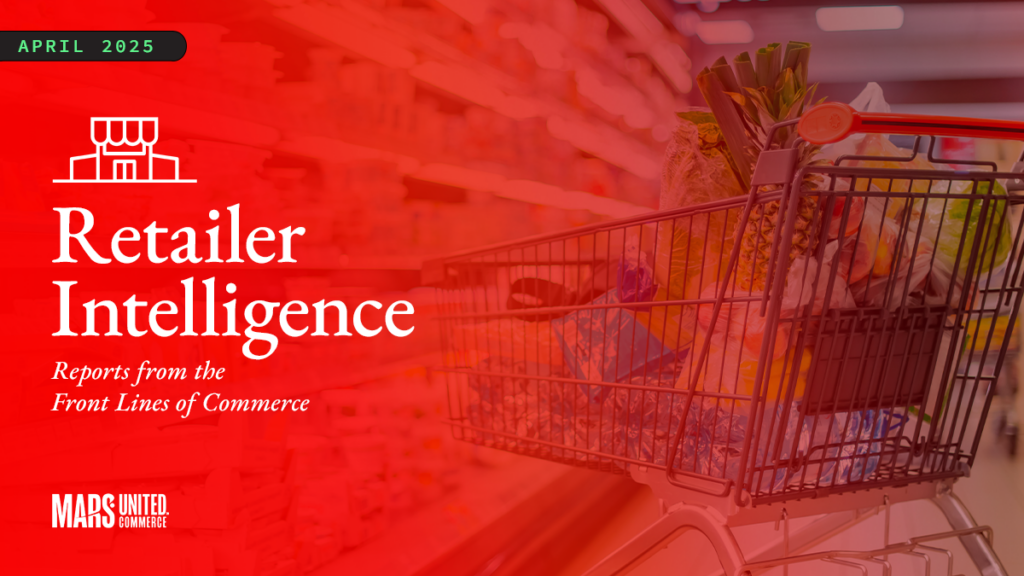Ten multi-talented and multi-channeled leaders from Mars United’s Commerce Practice examine the trends that will shape the industry in 2023 — along with some things they hope will happen, but probably won’t.
Plus, we evaluate how well our forecasters did predicting the trends that shaped 2022.
Download the full report as a pdf:
Mars United What to Expect at Retail 2023

Kandi Arrington
Group SVP, Customer Development
WHAT WILL HAPPEN:
Commerce Marketing will ‘rightsize’ to strike the correct balance for growth between digital and physical activation.
Retailers and brands will ease off the hyper-focus they’ve placed on digital commerce in the last few years, putting back more emphasis on what’s happening in the brick-and-mortar store and creating a better balance between the two environments.
This need for rightsizing became pretty clear in 2022 as the pace of ecommerce growth slowed after shoppers began returning to the store. The vast majority of sales still occur in brick and mortar, and you can’t grow online — or anywhere else — if you don’t keep supporting the base business at the physical shelf. Brands and retailers need to build joint plans that will strike the right balance between physical and digital activation, using the unique strengths of each in tandem to effectively cover all shopper needs, trip types, and product assortments.
Those returning shoppers, however, might not be as patient as they used to be now that they’ve experienced the convenience of online shopping. For one, they might be less forgiving about supply chain issues and out-of-stock situations. Retailers and brands will need to work harder to determine the right product assortment for the store shelf to give shoppers what they want — because it will be harder to win them back if they don’t get it.
A major opportunity exists for retailers and brands to marry the availability provided by the extended digital shelf with the instant gratification delivered at the store shelf. If I’m standing in the aisle and they don’t have the exact item I want, can I order it online and have it delivered to my house that afternoon?
Whoever creates that link will win with shoppers, but it will require retailers to rethink their category management and warehousing strategies, and brands to synch up their internal teams across category management, supply chain, sales, marketing and ecommerce to proactively provide that type of fulfillment. Connected commerce will be more important than ever.
WHAT SHOULD HAPPEN: (but probably won’t)
Retailers will break down internal silos to create the alignment needed to make that above scenario happen.
Some retailers are making strides, but no one is quite there yet.
With costs increasing, margins shrinking and retailers wary of raising prices too much, it’s a difficult time for them to make the investment in resources needed to build these kinds of on-demand delivery capabilities, or even to find partners that can help them do it profitably.
____________

Ethan Goodman
EVP, Media
WHAT WILL HAPPEN:
Retail media will extend into the physical store and help facilitate holistic planning.
Retail media networks have already made solid advancements in the areas of self-serve tools and measurement capabilities, but the next step in their evolution will be to better integrate digital and physical shopper engagement by incorporating in-store touch points into the toolbox.
By extension, that should help networks start doing a better job connecting the dots between their business and the merchant side of the retail enterprise, linking digital media with in-store merchandising and display activity to deliver holistic programs. This is the Holy Grail for brands, who would be less skeptical about the value of retail media and more willing to invest aggressively if they knew they were getting more bang for the buck and reaching shoppers consistently across channels.
This step is also advantageous for the networks themselves because it gives them more internal media inventory to offer brands. What’s more, it’s an opportunity that the traditional — and less expensive — performance media they’re competing against for ad dollars can’t replicate. Our clients are willing to pay a bit of a premium to get the targeting and closed-loop attribution that the retailer’s first-party data provides. But retailers can recognize the significant investments that are being made by unlocking incremental merchandising or distribution opportunities when and where it makes sense.
Brands need to continue pushing their retail media network partners to make in-store opportunities available and, more importantly, to facilitate these strategic connections between media and merchandising. They should bring this discussion to their JBP negotiations with the networks and find partners willing to consider a more connected approach that will bring media and merchant to the table together.
Finally, as these opportunities become available, brands should embrace a test & learn mindset: set costs aside for the time being, develop clear objectives about what they want to learn, run programs, and use the resulting insights to make decisions about how best to proceed.
WHAT SHOULD HAPPEN: (but probably won’t)
The retail media marketplace will consolidate.
We’re getting to the point where there are just too many retail media networks and not enough dollars to go around. Many brands are funding retail media initiatives at the biggest networks with pre-allocated, retailer-specific funds from shopper, trade or ecommerce budgets. And those budgets aren’t very large to begin with.
That leaves a lot of “long-tail” retail media networks scrapping for dollars that realistically will also only be available for the largest players like Amazon, Walmart Connect, Roundel, KPM, and maybe a few others. It’s going to be hard for other networks to get access to these dollars.
At some point, there probably will need to be a marketplace downsizing, with smaller networks aligning or consolidating to gain scale. Some of the existing third-party platform operators might be well-positioned to do that. (CitrusAd and Quotient, for instance, are already doing this with small retailers.) However, the overall funding issue will likely still be there.
In the near term, though, we expect to see more retail media networks rolling out.
____________

Fern Grant
EVP, Commerce Practice
WHAT WILL HAPPEN:
We will all start paying more attention to Gen Z.
Depending on which definition you use, there are roughly 70 million of them and, according to a 2021 Bloomberg report, they command $360 billion in disposable income. Born in a bust, they are budget-conscious and, unlike Millennials, they feel Walmart is a pretty cool place to shop.
Gen Z are highly self-aware and believe mental health should be an open topic for discussion, both personally and professionally. Ditto for sexuality, as they are more than five times as likely as the general population to identify as LGBTQ. They prefer visually based media and are choosing TikTok and YouTube over Instagram. They both embrace and distrust social media, so it is imperative that brands engaging in that space do so with authenticity and transparency.
Fun fact: By the end of 2023, about 40% of all babies will be born to this generation. Time to sit up and take notice!
WHAT SHOULD HAPPEN: (but probably won’t)
I am still looking for someone to develop a ‘Fernscart’ for me.
If you remember last year’s forecast, it’s a personal cart that shoppers can drag from one ecommerce platform to another to create a single “basket,” adding and subtracting items as much as they want. Pretty confident that isn’t going to happen this year either.
____________

Meghan Heltne
SVP, Customer Development
WHAT WILL HAPPEN:
The physical store will make a big comeback.
While we thought shoppers might never return to brick-and-mortar stores for a little while during the pandemic, it seems that many people actually did miss in-person shopping and are ready and willing to go back.
In fact, 80% of shoppers told Mood Media they are now comfortable going into stores, which is driving some serious traffic: Mood Media found that 38% of consumers globally are shopping in-store more often now than they did two years ago (and another 33% just as often). In-store sales are up by more than 13% compared to pre-2020 levels, according to Mastercard. And stores still account for 76% of total U.S. retail sales, says Forrester.
But while they might be the same shoppers as before, their expectations have changed. They’re now looking for retailers to deliver the following:
- Experiences that make the trip worthwhile.
- Digital opportunities that improve and expand the physical experience.
- Personalization that helps them solve their unique needs.
- Sustainability efforts that align with their own sensibilities.
Ecommerce is still an absolute must-win for brands, but we need to remember that the in-store environment is equally as important and make sure we plan our marketing activity, and our budgets, accordingly.
WHAT SHOULD HAPPEN: (but probably won’t)
Retailers will quickly up their digital game in-store.
Now that most consumers have a taste for ecommerce, retailers should evolve the in-store environment to further integrate with the online trip, delivering differentiated and personalized digital experiences that meet the new expectations of shoppers.
Ideally, retailers would react quickly to these new expectations and lean into digitally powered experiences. However, we know that integrating more immersive digital experiences like AR and VR will take time for retailers and brands. We certainly hope to see progress in 2023 but won’t expect perfection for a few years yet.
____________

Brian Higdon
SVP, Customer Development
WHAT WILL HAPPEN:
This will be a year heavy in mergers, acquisitions and divestitures. Call it the Great Reshuffling of 2023.
The first cards were thrown last October with the Kroger-Albertsons mega-merger announcement; Southeastern Grocers (parent company of Winn-Dixie, Fresco Y Mas and Harveys) then doubled down on major retailer transitions by announcing they are considering a possible sale — one year after withdrawing plans for an IPO.
This is likely just the start, as competitive pressure and economic uncertainty will make 2023 a year where the retail deck may get reshuffled, with some retailers looking to retrench and focus on core competencies, others taking advantage of the situation to acquire, and still others seeking to partner to grow.
Brands, therefore, need to be Perceptive, Prepared and Proactive:
- Be Perceptive: Watch the newswire, engage your retailers and know your numbers.
- Be Prepared: Start thinking now about how a merger could impact your business strategy, your structure, and your staffing.
- Be Proactive: Start war-gaming “what if” scenarios now.
With mega-mergers, economic uncertainty, and increased competitive forces on the horizon, it is likely that 2023 will be the year that the retail deck will undergo a reshuffling. As Kenny Rogers said, “You (as in retailers) got to know when to hold ‘em; know when to fold ‘em; know when to walk away; and know when to run.”
WHAT SHOULD HAPPEN: (but probably won’t)
Instacart will be acquired by a major retailer.
With its valuation declining from $39 billion to $13 billion in 2022, Instacart and its technology, data and workforce (both direct and gig) now represent a prime opportunity for acquisition.
This would totally shake up the ecommerce delivery market. The acquirer could gain invaluable insights into shoppers beyond its own customer base and have other retailers over a barrel. And the deal would hamstring (or at least significantly slow) any retailers who chose to cease their business with Instacart.
Despite this potential, a deal likely won’t happen because Instacart may need to significantly pivot their current business model to address the valuation decline. And the possibility of other retailers ceasing to partner with Instacart if they’re purchased by a competitor would have a major impact on the company’s financial base. It would be an extremely bold maneuver and competitive strike for a retailer, but the risks will likely outweigh the potential upside.
Either way, this scenario serves as a reminder that brands should understand the ecommerce business models for each of their retailers, today and in the future. An important part of that is understanding what service providers they use for home delivery, and their capabilities and outages.
____________

Theresa Lyons
SVP, Strategic Planning
WHAT WILL HAPPEN:
‘Recommerce’ will expand to new and interesting places.
“Recommerce” — selling previously owned items — has taken off in categories like apparel, home goods, furniture, sports equipment, and electronics. In fact, the recommerce market is projected to reach $289 billion by 2027 and grow five times faster than the overall retail market, according to the OfferUp Recommerce Report 2022. Maybe that’s why retailers like Walmart (with Walmart Restored) are getting involved.
The concept is particularly appealing to Gen Z and Millennials, who favor sharing vs. owning. And with economic uncertainty continuing in 2023, recommerce will keep appealing to shoppers who love finding great deals and even earning a little extra money themselves. It’s also attractive to younger generations, who have a greater concern for the environment, because it extends the lifecycles of products.
Here are a few considerations for retailers:
- Build loyalty by providing an easy-to-use mechanism and fair market prices for used goods, allowing consumers to further engage with their brand.
- Acquire new customers by accepting goods that can be repaired or reconditioned for resale, or use recommerce as an outlet for all store returns.
- Incorporate recommerce into sustainability initiatives.
WHAT SHOULD HAPPEN: (but probably won’t)
Marketers will avoid turning shoppers into algorithms.
Data has become invaluable to marketers. It helps us target shoppers by letting us understand how they behave, what they buy, the media they consume, and more. But we must remember that there are human beings at the end of those data points who we’re trying to connect with.
Marketers need to go beyond the logic of the data and take the time to understand how people feel. I worry that we’re becoming so consumed with having the right data that we’re forgetting to show empathy toward the shopper. But there are a few easy things you can do to avoid this:
- Have conversations with your shoppers to see beyond the data points and understand who they are and what their lives are like.
- Be solutions oriented. Shoppers aren’t looking for “items” but for solutions that can help them and their families.
- Be relatable. Ensure that you’re building content that connects with their emotional drivers, not just their data points.
Data will continue to be invaluable, but let’s not lose sight of the humans with whom we’re trying to relate.
____________

Barb Seman
VP, Customer Development
WHAT WILL HAPPEN:
Small format retailers will continue to leverage technology and 1P data to drive engagement.
Retailers in the Drug, Value and C-Store channels will continue to expand their digital arsenals, focusing the efforts on providing convenience and driving in-store engagement — from pickup and delivery, to health services, to foodservice offerings.
Dollar General offers pickup in-store and launched DoorDash delivery, and shoppers have responded to these services. Walgreens and CVS continue to expand their health service partnerships to bring care to local communities. C-stores are adding more relevant food offerings and faster pickup to strengthen their convenience positioning.
Brands have an opportunity to engage with these retailers by leveraging each one’s insights and incorporating these services into their programming.
WHAT SHOULD HAPPEN: (but probably won’t)
Brands and retailers will rethink their approach to the small format shopper.
Shoppers have specific reasons for visiting different retailers in small format channels. Brands need to address these differences to optimize the unique positioning of each retailer partner. And retailers need to be better partners for brands by taking a holistic view of investments across merchandising, marketing, and retail media — without a “one size-fits all” investment expectation. The one size fits all approach taken by both brands and small format retailers often stalls the growth opportunities each side is seeking. Return on investment is a goal both need to embrace to help drive true partnerships.
Brands need to shape a new story for how they can support each retailer’s specific goals for growth, and retailers in return need to better work with brands on mutually beneficial partnerships.
____________

Kat Ussery
Director, Emerging Channels
WHAT WILL HAPPEN:
On-demand delivery will become a mainstream channel for CPG brands.
It’s time to stop calling on-demand delivery an “emerging” channel. The marketplace has achieved maturity and scale, with a number of startups folding or consolidating but leading companies like Instacart, DoorDash and Gopuff (who’ve also made some adjustments), along with Shipt and Uber, becoming a vital component of the ecommerce landscape.
The trends in online shopping and quick-service home delivery that took hold during the pandemic may have subsided a little but they’re not going away, especially among younger shoppers who can often be hard to reach through more traditional retail channels.
What’s more, as newcomers to the grocery scene, the leading players are focusing on innovation. Instacart, for one, is on a mission to transform its shopper experience from transactional to inspirational, and brand engagement will play a significant role in this evolution.
That makes on-demand delivery providers ideal partners for brands, even during an economic downturn — in fact, on-demand leaders are responding to the current climate by focusing more on value, offering more promotions and price deals to give their shoppers a reason to build bigger baskets. Whether you have 200 SKUs or even just 20 available through these platforms, it’s time to consider increasing investment.
WHAT SHOULD HAPPEN: (but probably won’t)
All brands will embrace the on-demand delivery channel.
There is often a disconnect between what brands should do and what they actually do, especially during inflationary periods like the one we’re in now. It will be hard for many organizations to justify investing more dollars in a new channel when they’re considering overall reductions to their budgets.
But they should, even if it means considering an investment from the brand marketing budget. While “quick commerce” operators might seem as bottom of the funnel as you can get, the market leaders offer a national media opportunity that spans the full shopper journey and gives brands a chance to engage with a younger audience.
Millions of shoppers have grown to love the ease and convenience provided by on-demand delivery providers. Brands should increase their love, too.
____________

Victoria Van Dusen
SVP, Customer Development
WHAT WILL HAPPEN:
Personalization will continue evolving toward mass market retail.
Think of the personalized products available through Nike for You or the curated items delivered by Stitch Fix and Fab Fit Fun — but expanded into mass categories like pet, beauty and healthcare.
Although subscription services may experience a decline in an economy struggling with inflation, shoppers otherwise still expect some form of personalization given the amount of data that they share with brands and retailers. The organizations that can find a way to meet the evolving wants and needs of the shopper and execute at scale will put themselves on the cutting edge.
This doesn’t just apply to products. Shoppers also expect a personalized approach to advertising, which can be delivered by creating a unique experience across their shopping journey.
We’ll also will see more retailers and brands leveraging augmented reality in “try before you buy” opportunities that simulate — or even improve — the in-store experience: offering “virtual dressing rooms” to aid apparel purchases or letting home improvement shoppers see what a new paint color or piece of furniture will look like in their home.
These technologies aren’t new, but they’re expanding into all retail channels and product categories. Making it easy for shoppers to access these tools online will become more of a focus for retailers. And brands that can integrate these technologies into their digital experiences with key retailers will gain the inside track.
WHAT SHOULD HAPPEN: (but probably won’t)
The in-store environment in mass retail will become more engaging and experiential.
The time is ideal for retailers to rethink the in-store experience to drive loyalty and engagement as post-COVID consumers return to in-person shopping. The majority of sales still come through brick-and-mortar stores, and just as e-retailers are finding ways to bring the store experience online, retailers need to find ways to elevate the in-store experience.
But the same old complications related to executing at scale (with costs at the top of the list) will probably keep this from happening. Retailers will remain focused on price, delivery methods and supply chain.
Brands, therefore, should consider developing unique programs that will help retailers evolve the in-store experience. Here are two possibilities: Move beyond simple handouts and samples to train ambassadors who can engage and educate shoppers; and use technology to connect the in-store shopping experience with the digital shelf.
____________

John Willkom
SVP, Ecommerce
WHAT WILL HAPPEN:
Inflationary pressure and rising interest rates will force retailers to focus on value.
Taylor Swift will have the largest security team ever in the history of live events! After Ticketmaster dropped the ball and COVID-19 (supposedly) ended, people will be out in droves to catch 2023’s most anticipated music tour.
OK, back to retail. Inflationary pressure and rising interest rates will persist in 2023, putting pressure on retailers to show their value. This will be the year that data truly takes the wheel for brands. By that, I mean by guiding P&L analysis over the entire business as opposed to just by retailer. Brands will evaluate spending holistically and better understand the costs and incrementality measures associated with one budget.
This requires visibility into unit economics by retailer: If I can make 10% more profit at Retailer A with CPCs/CPMs at a 10% lower cost, I have a valid business case to build there.
Ecommerce has opened the door to understanding the true costs of marketing activation. Gone are the days of lump-sum budgets for a list of tactics. Moneyball the movie premiered in 2011; 2023 will be the year of Moneyball in retail.
WHAT SHOULD HAPPEN: (but probably won’t)
DTC will get even more direct.
Given the inflationary environment, shoppers will continue looking for value. Imagine an Alibaba pop-up store where shoppers could walk in, see/touch/experience certain items in person, and then place an order online for direct delivery to their home. Well, what’s new or novel about that, John?
In a global economy, I see a future where original equipment manufacturers create a robust DTC business with consumers. My wife and I just bought a treadmill. The irony is that I could’ve ordered the same treadmill, with the same specs, directly from the factory in China and saved more than 400% on the cost. Of course, my wife said, “No way,” but more because it’s literally a foreign concept right now than because of any real concerns.
____________
2022 Forecast Assessment
Unlike most industry analysts, we’re not afraid to evaluate how well we did last year (especially when we did really, really well).
Kandi Arrington
Forecast: Content commerce will become the new form of impulse purchase.
Did It Happen? Yes. It certainly had an impact on my own pocketbook! Mainstream retailers like Walmart and Target have experimented with shoppable content on social platforms like TikTok, Instagram, and Facebook. They’re also conducting livestream shopping events that have consumers taking advantage of one-click opportunities to “see something, buy something.” These initiatives are even becoming part of their retail media network offerings.
Ethan Goodman
Forecast: “Distributed commerce” will become mainstream.
Did It Happen? Yes. But full disclosure: It didn’t quite explode the way I thought it would, at least in part because it was overshadowed by retail media.
But there was plenty of social commerce through platforms like TikTok (although Facebook stopped its efforts), livestream shopping through Walmart and other retailers, content-related activity like shoppable recipes from brands, and even some things happening in the metaverse. So the explosion could be on the way.
Fern Grant
Forecast: Brands will stop looking and acting the same across all e-commerce platforms.
Did It Happen? I am excited to say this is happening! We do a lot of audits for our clients, and we’re finding different content being used on different marketplaces. Although it includes unique copy, we are especially seeing brands utilize different images, claim cards and videos in their carousel. They’re all aligned to the brand, but appropriate for that particular marketplace and the people who are shopping there.
Unfortunately, I was also correct about what should happen but probably wouldn’t: The digital shopping experience will be completely transformed. We keep talking about highly personalized, voice-activated, virtual shopping experiences, but it’s all still pretty functional.
Meghan Heltne
Forecast: Sustainability will shift from being an added benefit to a mandate.
Did It Happen? Sort of. We saw some great progress with sustainability efforts in 2022. We saw brands launch sustainable product and packaging innovation. And we saw retailers roll out even more sustainable solutions, like greener supply chains, net zero energy stores even partnerships with sustainable farms to source private label products.
But we know sustainability is a long-term goal that will continue evolving for years to come, so we expect this to be a retail trend again in 2023 and well into the future. Sustainability has become a priority for consumers, and therefore must be a priority for brands and retailers as well.
Brian Higdon
Forecast: The “Great Resignation of 2021” will lead to the “Great Reorganization of 2022.”
Did it Happen?: Sort of. Many companies (if not most) have reevaluated their structures, and some are now undertaking significant layoffs, especially big tech and quick commerce firms.
Theresa Lyons
Forecast: Shoppers will trade down in some categories so they can trade up in others.
Did it Happen?: Yes. It definitely has been a rough financial year for many shoppers. Gas prices were high, food and beverage costs increased, housing costs rose; there were very few categories that didn’t get more expensive. Trading down definitely happened, as retailers enjoyed strong private label sales — with many shoppers indicating that they’ll continue to purchase them in the future.
Meanwhile, as indicated in my recommerce prediction for 2023, the trade up seems to be coming from buying designer brands through resale sites. Shoppers are savvy and will always find a way to get what they need at a price they want to pay.
Barb Seman
Forecast: Innovation at small format retailers will require national brands to take notice.
Did it Happen?: Yes. Walgreens and CVS strengthened their healthcare offerings with investments in, respectively, VillageMD and Signify Health, bringing care closer and more conveniently to their shoppers. Dollar General launched and is aggressively expanding its retail media network, focusing the effort on how their shoppers prefer to engage: in the store. C-stores are redefining convenience with foodservice offerings appealing to harried Millennial parents and social media activity building engagement with Gen Z; 7-Eleven entered the retail media arena with Gulp Media Network, and other c-stores are following suit.
John Willkom
Forecast: Success in 2022 will be less about changing the consumer experience and more about re-inventing the guts behind the scenes.
Did It Happen? Yes. We had a tough macro environment in 2022, and brands and retailers were forced to adapt in multiple ways. No, Walmart did not buy Pinterest (what I suggested should happen), but new partnerships with TikTok, Roku, and The Trade Desk all point to a retailer building an ecosystem rather than just a marketplace. Walmart has arguably the strongest back-end foundation in retail, and they are right to lean on this — even when the sale occurs on social platforms or streaming TV.
Download the full report as a pdf:
Mars United What to Expect at Retail 2023
____________
About Mars United Commerce
Mars United Commerce is an independently owned global commerce marketing practice that aligns people, technology, and intelligence to make the business of our clients better today than it was yesterday. Our worldwide capabilities coalesce into four key disciplines — Strategy & Analytics, Content & Experiences, Digital Commerce, and Retail Consultancy — that individually deliver unmatched results for clients and collectively give them an unparalleled network of seamlessly integrated functions across the entire commerce marketing ecosystem. These disciplines are powered by our industry-leading technology platform, Marilyn®, which helps marketers understand the total business impact of their commerce marketing activation, enabling them to make better decisions, create connected experiences, and drive stronger, measurable results. Learn more at https://www.marsunited.com/



